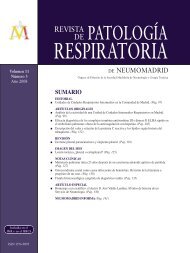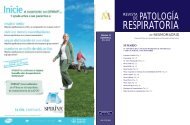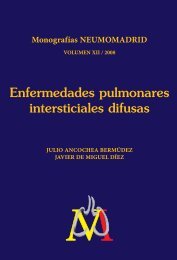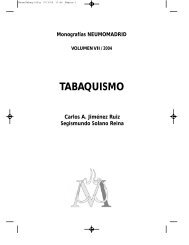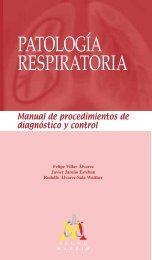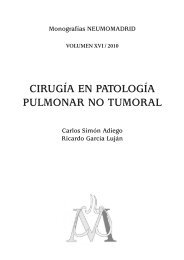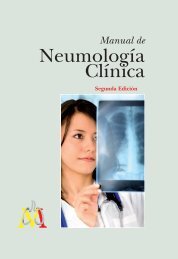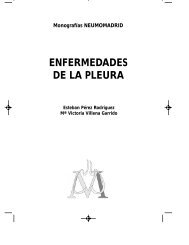Enfermedades pulmonares intersticiales difusas - Neumomadrid
Enfermedades pulmonares intersticiales difusas - Neumomadrid
Enfermedades pulmonares intersticiales difusas - Neumomadrid
Create successful ePaper yourself
Turn your PDF publications into a flip-book with our unique Google optimized e-Paper software.
les alveolares puede tener un efecto beneficioso<br />
en el tratamiento de la fibrosis. En lo que<br />
respecta a la genética y, si bien diferentes estudios<br />
indican que la FPI es una enfermedad poligénica,<br />
lo que dificulta la identificación de dianas<br />
moleculares para futuras genoterapias,<br />
sigue siendo en la actualidad una vía abierta<br />
de investigación. El papel de las células troncales<br />
y su posible implicación en la regeneración<br />
del epitelio alveolar de la mano, tal vez,<br />
de la llamada clonación terapéutica, constituye<br />
otra estrategia de futuro (44-46) .<br />
Enfoque terapéutico actual en la FPI<br />
En la figura 4 se expone el algoritmo terapéutico<br />
de la FPI. Una vez establecido el diagnóstico,<br />
ante la ausencia de evidencia científica<br />
que justifique el uso de un determinado<br />
fármaco en la FPI, se recomienda revisar si el<br />
paciente cumple los requisitos necesarios para<br />
participar en cualquiera de los ensayos clínicos<br />
experimentales en curso (47) . En caso de que<br />
el paciente no cumpla los criterios de inclusión,<br />
no desee participar o no tenga accesibilidad<br />
a un centro con un ensayo clínico en curso,<br />
debe analizarse detalladamente, de acuerdo<br />
con el paciente, los riesgos y beneficios del tratamiento<br />
clásico. En caso de iniciar dicho tratamiento<br />
administraremos azatioprina, prednisona<br />
y NAC según las dosis establecidas en<br />
el consenso, monitorizando la función pulmonar<br />
a los 6 meses. Si se objetiva mejoría o<br />
estabilidad clínica y funcional respiratorias,<br />
mantendremos dicho tratamiento. Si el paciente<br />
experimenta empeoramiento, se recomienda<br />
su retirada. La oxigenoterapia domiciliaria<br />
se indicará cuando sea necesario y a<br />
los pacientes seleccionados se les remitirá a<br />
una unidad de trasplante pulmonar.<br />
BIBLIOGRAFÍA<br />
1. American Thoracic Society. Idiopathic pulmonary<br />
fibrosis: diagnosis and treatment.<br />
International consensus statement. Am J Respir<br />
Crit Care Med. 2000; 161: 646-64.<br />
2. American Thoracic Society/European Respiratory<br />
Society. International multidisciplinary<br />
FIBROSIS PULMONAR IDIOPÁTICA<br />
consensus classification of the idiopathic interstitial<br />
pneumonias. Am J Respir Crit Care Med.<br />
2002; 165: 277-304.<br />
3. Katzenstein AL, Myers IL. Idiopathic pulmonary<br />
fibrosis. Clinical relevance and pathologic<br />
classification. Am J Respir Crit Care Med.<br />
1998; 157: 1301-15.<br />
4. Xaubet A, Ancochea J, Morell F, Rodríguez Arias<br />
JM, Villena V, Blanquer R, et al. Report of the<br />
incidence of interstitial lung disease in Spain.<br />
Sarcoidosis Vasc Diffuse Lung Dis. 2004; 21:<br />
64-70.<br />
5. Tobin RW, Pope CE 2nd, Pellegrini CA, Emond<br />
MJ, Sillery J, Raghu G. Increased prevalence of<br />
gastroesophageal reflux in patients with idiopathic<br />
pulmonary fibrosis. Am J Respir Crit<br />
Care Med. 1998; 158: 1804-8.<br />
6. Raghu G, Freudenberger TD, Yang S, Curtis JR,<br />
Spada C, Hayes J, et al. High prevalence of<br />
abnormal acid gastro-oesophageal reflux in<br />
idiopathic pulmonary fibrosis. Eur Respir J.<br />
2006; 27: 136-42.<br />
7. Selman S, King TE, Pardo A. Idiopathic pulmonary<br />
fibrosis: prevailing and evolution hypothesis<br />
about its pathogenesis and implications for therapy.<br />
Ann Intern Med. 2001; 134: 136-51.<br />
8. Border WA, Noble NA. Transforming growth<br />
factor beta in tissue fibrosis. N Engl J Med.<br />
1995; 331: 1286-92.<br />
9. Abdollahi A, Li M, Ping G, Plathow C, Domhan<br />
S, Kiessling F, et al. Inhibition of platelet-derived<br />
growth factor signaling attenuates pulmonary<br />
fibrosis. J Exp Med. 2005; 201: 925-<br />
35.<br />
10. Hamada N, Kuwano K, Yamada M, Hagimoto<br />
N, Hiasa K, Egashira K, et al. Anti-vascular<br />
endothelial growth factor gene therapy attenuates<br />
lung injury and fibrosis in mice. The<br />
Journal of Inmunology. 2005; 175: 1224-31.<br />
11. Shi-When X, Denton CP, Dashwood MR, Holmes<br />
AM, Bou-Gharios G, Pearson JD, et al.<br />
Fibroblast matrix gene expression and connective<br />
tissue remodelling: role of endothelin-<br />
1. J Invest Dermatol. 2001; 116: 417-25.<br />
12. Cantin AM, North SL, Fells GA, Hubbard RC,<br />
Crystal RG. Oxidant-mediated epithelial cell<br />
injury in idiopathic pulmonary fibrosis. J Clin<br />
Invest. 1987; 79: 1665-73.<br />
13. Saleh D, Barnes PJ, Giaid A. Increased production<br />
of the potent oxidant peroxynitrite in<br />
the lungs of patients with idiopathic pulmonary<br />
fibrosis. Am J Respir Crit Care Med. 1997;<br />
155: 1763-9.<br />
49



